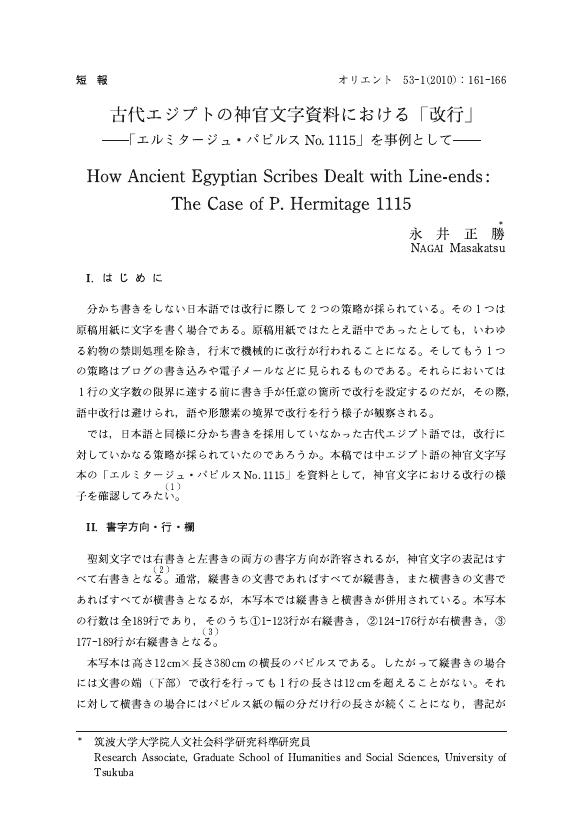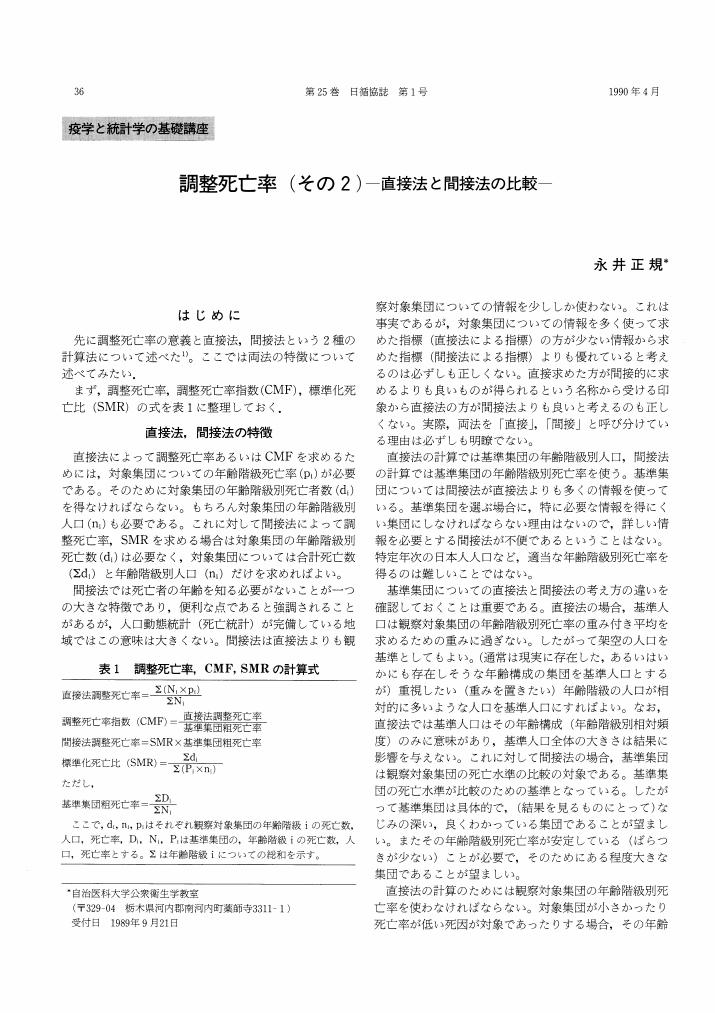- 著者
- 冨澤 かな 木村 拓 成田 健太郎 永井 正勝 中村 覚 福島 幸宏
- 出版者
- 一般社団法人 情報科学技術協会
- 雑誌
- 情報の科学と技術 (ISSN:09133801)
- 巻号頁・発行日
- vol.68, no.3, pp.129-134, 2018-03-01 (Released:2018-03-01)
東京大学附属図書館U-PARL(アジア研究図書館上廣倫理財団寄付研究部門)は,本学所蔵資料から選定した漢籍・碑帖拓本の資料画像をFlickr上で公開している。資料のデジタル化とアーカイブ構築のあり方を模索した結果,限られたリソースでも実現と持続が可能な,小さい構成でありながら,広域的な学術基盤整備と断絶せず,高度な研究利用にも展開しうる,デジタルアーカイブの「裾野のモデル」を実現しうる方策として選択したものである。その経緯と現状及び今後の展望について,特に漢籍・碑帖拓本資料の統合メタデータ策定,CCライセンス表示,OmekaとIIIFを利用した研究環境構築の試みに焦点をあてて論ずる。
33 0 0 0 OA <書評>聖刻文字版『ピーターラビットのおはなし』
- 著者
- 永井 正勝
- 出版者
- 筑波大学一般応用言語学研究室
- 雑誌
- 言語学論叢 (ISSN:0914966X)
- 巻号頁・発行日
- no.24, pp.55-66, 2005-12-31
33 0 0 0 OA ギルガメシュ叙事詩の編集史的研究および物語言語研究のためのデジタルアーカイブ構築
本研究は、前二千年紀から前一千年紀にかけて、古代オリエント地方で広く親しまれたギルガメシュ叙事詩のデジタル・アーカイブを構築するものである。ギルガメシュ叙事詩は、前二千年紀初頭に成立した古バビロニア語版と、前二千年紀末に成立した標準版が、ある程度現存している。そこで、古バビロニア語版と標準版の異同をデジタル処理可能なかたちでアーカイブ化することで、テクストの対応関係ならびに発展段階をある程度まで可視化することができた。本研究で開発されたデジタル化の枠組みは、言語研究や文学研究に広く応用することが可能である。
17 0 0 0 OA Linked Data化した典拠データとIIIFを用いた法帖の異版比較支援システムの開発
- 著者
- 中村 覚 成田 健太郎 永井 正勝
- 雑誌
- じんもんこん2018論文集
- 巻号頁・発行日
- vol.2018, pp.297-302, 2018-11-24
法帖の研究において,版の異同を検討し,その系統を詳らかにすることは肝要である.本研究ではこのような法帖研究の支援を目的として,法帖における異版作品の比較を支援するシステムを開発した.典拠データのLinked Data 化と,複数機関が提供するIIIF 準拠画像に対するアノテーション付与による個別作品の識別により,異版関係にある個別作品を検出可能なシステムを構築した.国立国会図書館,国文学研究資料館,東京大学附属図書館が提供する法帖画像を対象としたケーススタディを通じ,版6 件,著者252 件,作品902 件,異版作品1403 件から構成される典拠データの作成,および213 件の個別作品に対して紐づけを行い,任意の異版作品の異なる個別資料における再現例を検出できることを確認した.
16 0 0 0 OA タッチパネル使用時における手指操作特性の世代間比較
- 著者
- 永井 正太郎 福本 梨乃 山下 久仁子 岡田 明
- 出版者
- ヒューマンインタフェース学会
- 雑誌
- ヒューマンインタフェース学会論文誌 (ISSN:13447262)
- 巻号頁・発行日
- vol.20, no.4, pp.469-478, 2018-11-25 (Released:2018-11-25)
- 参考文献数
- 15
- 被引用文献数
- 1
Touchscreens are common in personal devices as well as in public devices such as ATMs and vending machines, because they are customizable and require less mental and physical load. However, touchscreens are subject to human error and visual overload, because a touchscreen interface doesn’t have haptic clues. Furthermore, the elderly may tend to be more affected by these issues. We conducted the experiment by measuring finger movement and finger contact force while using a touchscreen, to ascertain suitable feedback from haptic clue for both the elderly(62-75 years old) and younger people(20-30years old) . The findings were as follows: The amount of finger movement and finger contact force of elderly participants were significantly more than that of the younger participants (p < 0.01). Increased finger movement was due to tremors and decreased dexterity caused by aging. Increased finger contact force was due to two reasons: first, a response to less haptic feedback than what elderly participants are accustomed to experience, such as in the operation of a mechanical button; second, an attempt to prevent an error in movement due to their tremor. In addition to the physiological measurements, interviews of the participants revealed that the reason for their differences in using ICT devices is not a lack of experience, but physiological issues, such as tremors, decreased sensation in aging. The study further confirmed that touchscreen designs should include larger buttons and text display and a haptic experience that is attuned to strong finger contact force to promote greater usability for elderly users.
12 0 0 0 OA 古代エジプトの神官文字資料における「改行」
- 著者
- 永井 正勝
- 出版者
- 一般社団法人 日本オリエント学会
- 雑誌
- オリエント (ISSN:00305219)
- 巻号頁・発行日
- vol.53, no.1, pp.161-166, 2010-09-30 (Released:2014-03-31)
- 被引用文献数
- 1
9 0 0 0 OA 大学生の学習意欲,大学生活の満足度を規定する要因について
- 著者
- 見舘 好隆 永井 正洋 北澤 武 上野 淳
- 出版者
- 日本教育工学会
- 雑誌
- 日本教育工学会論文誌 (ISSN:13498290)
- 巻号頁・発行日
- vol.32, no.2, pp.189-196, 2008-10-20 (Released:2016-08-05)
- 参考文献数
- 22
- 被引用文献数
- 1
学生の「学習意欲」や「大学生活の満足度」は,どのような要因が押し上げているのか.想定される様々な要因を探るアンケートを公立S大学の学生に実施し,その結果から因子分析によって「学習意欲」「大学生活の満足度」に影響を与えていると想定される因子を抽出した.そして抽出された因子間の因果関係を共分散構造分析にて分析した結果,「教員とのコミュニケーション」は「学習意欲」を高め,さらに「大学生活の満足度」にも影響を与えていた.また,「友人とのコミュニケーション」は「大学生活の満足度」にあまり影響を与えておらず,「学習意欲」には関連がないことが示唆された.
- 著者
- 伏木田 稚子 永井 正洋
- 出版者
- 一般社団法人 日本教育工学会
- 雑誌
- 日本教育工学会論文誌 (ISSN:13498290)
- 巻号頁・発行日
- pp.44143, (Released:2021-06-22)
- 参考文献数
- 35
本研究では,生涯学習を支える情報リテラシーの育成に着目し,シニア世代が大学開放事業において幅広く継続的に学知を学ぶ上で,授業内容にどのような観点を取り入れるべきかを探索的に検討した.具体的には,コンピュータの利活用に関する実態を幅広く把握した上で,性別や年齢,最終学歴など,学習者の基本情報を考慮しながら,コンピュータの利用目的,活用経験,利用不安の関係を分析し,授業実践の要件を明らかにすることを目的とした.TMUプレミアム・カレッジの履修生53名を対象に質問紙調査を行った結果,1) コンピュータの未所有者や初心者への配慮,2) 基礎を押さえた段階的な授業構成と初歩からの支援,3) 授業での活用機会の充実と日常的な利用の促進によるコンピュータの利用不安の軽減が,シニア世代の情報リテラシー教育に重要な観点であることが示唆された.
5 0 0 0 必携入門ヒエログリフ : 基礎から学ぶ古代エジプト語
- 著者
- 高橋 美保子 永井 正規
- 出版者
- 一般社団法人日本衛生学会
- 雑誌
- 日本衛生学雑誌 (ISSN:00215082)
- 巻号頁・発行日
- vol.63, no.1, pp.5-19, 2008-01-15 (Released:2008-05-16)
- 参考文献数
- 38
- 被引用文献数
- 14 14
Objectives: The aim of this study is to clarify the excess mortality associated with influenza epidemics in Japan during the period from 1987 to 2005.Methods: Monthly data on the total number of deaths (excluding accidental deaths) and the numbers of deaths due to malignant neoplasms, heart disease, cerebrovascular disease, pneumonia, and renal failure were obtained from vital statistics from 1987-2005. The point estimates and range of excess mortality were evaluated using a model based on annual mortality and seasonal indices. Total mortality was analyzed for all ages, sex and for the following five age groups: 0-4, 5-24, 25-44, 45-64, and ≥65 yrs.Results: The excess number of deaths showed almost no difference in each influenza season between men and women. During each influenza season, approximately 85-90% of the excess mortality was attributed to the ≥65 yrs age group. During the 1995 and 1999 seasons, mortality increased significantly across all age groups. The highest point estimate of excess mortality in the ≥65 yrs age group was observed in 1999. From a comparison of the range of excess mortality in the ≥65 yrs age group by year, the excess mortality in 1995 appeared to be the highest of the examined years. The highest point estimate of excess mortality in the 0-4 yrs age group was observed in 1995. From a comparison of the range of excess mortality in the 0-4 yrs age group by year, the excess mortality in 1998 or 1999 appeared to be the highest of the examined years. Excess mortality in the 45-64 yrs and ≥65 yrs age groups showed an increasing tendency in the 1990s and a stabilizing tendency beginning in 2000. In addition, excess mortality during each epidemic was occurred in persons with pneumonia, heart disease, cerebrovascular disease, malignant neoplasms, and renal failure, accounting for approximately 20-50%, 20-40%, 20%, 5%, and 2% of all the excess mortality, respectively.Conclusions: These results indicate that the majority of excess mortality occurred among the elderly and persons with pneumonia, heart disease, or cerebrovascular disease. Although it is unclear whether the increasing trend in the 1990s and the stabilizing trend beginning in 2000 were the result of vaccination measures, health measures for groups such as the elderly and heart disease patients are considered to be important for the future.
4 0 0 0 OA 古代エジプト聖刻文字の書字方向 : 一般統字論構築の一助として
- 著者
- 永井 正勝
- 出版者
- 筑波一般言語学研究会
- 雑誌
- 一般言語学論叢 (ISSN:13443046)
- 巻号頁・発行日
- no.8, pp.21-45, 2005-12-31
3 0 0 0 IR 表記形式と言語形式のポーカーフェース : 中エジプト語にみる文献言語研究の難しさ
- 著者
- 永井 正勝
- 出版者
- 筑波大学文藝・言語学系
- 雑誌
- 文藝言語研究. 言語篇 (ISSN:03877515)
- 巻号頁・発行日
- no.63, pp.53-67, 2013
3 0 0 0 Hieratische Paläographie DBの構築
- 著者
- 中村 覚 永井 正勝 和氣 愛仁 高橋 洋成
- 雑誌
- じんもんこん2020論文集
- 巻号頁・発行日
- no.2020, pp.191-196, 2020-12-05
- 著者
- 永井 正勝 和氣 愛仁 高橋 洋成
- 雑誌
- 研究報告人文科学とコンピュータ(CH) (ISSN:21888957)
- 巻号頁・発行日
- vol.2019-CH-119, no.14, pp.1-7, 2019-02-09
一般言語学的なスタンスで様々な時代や地域の言語を統一的に扱おうとした場合に,どのような言語学的データの整理の仕方が必要なのかという観点は,データベース構築の際のプラクティカルな問題であると同時に,その整理行為そのものが,言語のあり方を記述する記述言語学の一形態としての価値を有する.本発表では,このような問題意識のもと,文字の直線的な羅列のみを見ていても言語構造が見え難いような文字資料をも対象としつつ,文字資料が持つ情報の,何を,どのように,整理 ・ 構造化して,それらを情報処理に結びつけていくべきなのか,という点について言語学の立場から提案を行う.
- 著者
- 高橋 洋成 永井 正勝 和氣 愛仁
- 出版者
- 一般社団法人情報処理学会
- 雑誌
- 研究報告人文科学とコンピュータ(CH)
- 巻号頁・発行日
- vol.2015, no.5, pp.1-5, 2015-01-24
近年のコンピュータとインターネットの発展に伴い,これまでコンピュータ上では転写テキストとして扱われることの多かった言語資料を,音声,動画,画像と一緒に保存・利用することが容易になった.著者らは古代エジプト神官文字文書,楔形文字粘土板資料,近代日本語文典資料などの文字資料を統一的に扱うための画像データベースと,World Wide Web 上のプラットフォームを構築している.さらに,本プラットフォームは次の 2 点を目指している.(1) 本プラットフォームの内部に格納された言語資料および研究データを,外部に保存し共有するために Text Encoding Initiative (TEI) を利用すること.(2) データの保存と共有をさらに促進させるために,言語資料と研究データに関する RDF トリプルを生成し,Linked Open Data (LOD) として提供すること.本稿はこの 2 点について,現在までの取り組みと具体例を報告する.Recent development of the internet and computer technologies makes it easier to compile various linguistic materials such as audios, videos and photos with their transliteration texts together. The authors are constructing the general-purpose image database and the platform on World Wide Web for the linguistic studies on hieratic texts of Ancient Egypt, cuneiform tablets of Ancient Orient, and Modern Japanese Grammar Textbooks. The platform aims on the following two points: (1) to use Text Encoding Initiative (TEI) for preservation and sharing of the internal data with its outer world, (2) to create sharable RDF triples from the data to provide them as Linked Open Data (LOD). The current snapshot of the developing platform will be discussed.
- 著者
- 永井 正勝 Nagai Masakatsu
- 出版者
- 筑波大学文藝・言語学系
- 雑誌
- 文藝言語研究. 言語篇 (ISSN:03877515)
- 巻号頁・発行日
- vol.58, pp.43-54, 2010-10-31
3 0 0 0 OA 後期ポロツキー説における中エジプト語の文/節体系
- 著者
- 永井 正勝
- 出版者
- 一般社団法人 日本オリエント学会
- 雑誌
- オリエント (ISSN:00305219)
- 巻号頁・発行日
- vol.43, no.1, pp.19-39, 2000-09-30 (Released:2010-03-12)
- 参考文献数
- 27
The main subject of Middle Egyptian studies should be to seek its “langue” through careful analysis of the instances of “parole.” But many Egyptologists, such as Erman, Sethe, and Gardiner, did not fully recognize the importance of the “langue” of Middle Egyptian, instead they paid great attention to the study of morphological differences in the instances of “parole” themselves, and adapted the Semitic system to these differences. From the point of linguistics, however, morphological studies that are separated from the “langue” may possibly lead to misunderstandings of language.It was the linguist Hans Jakob Polotsky who first established the Middle Egyptian “langue” system through the analysis of grammatical categories and syntax. The German scholar Friedrich Junge also developed his grammatical study based on syntax and the “transformationsgrammatik” of Chomsky. By so doing, Polotsky and Junge disproved of the old-fashioned method of the Egyptologists' “Morphological Grammar, ” but there are also differences in the understanding of Middle Egyptian sentence system between Polotsky and Junge. Despite these differences, Leo Depuydt combined these two distinct studies and gave them the label “Standard theory.” Nowadays many scholars regard Polotsky's Idea as “Standard theory” according to Depuydt's terminology. It must be noted, however, that such a label is quite unsatisfactory since “Standard theory” does not equal to Polotsky's Idea, and that the very main point of Polotsky's Idea has been neglected by using such an unfortunate label. It is now clear that the subject with which we must grapple is to clarify the main point of Polotsky's Idea.In this paper I will examine Polotsky's Idea and point out the following Middle Egyptian sentence system explained by Polotsky. 1) There is a distinction of mode in Middle Egyptian. 2) The indicative mode of the main sentence is introduced by an auxiliary and has three tenses (i. e., present, past, future). 3) Some of the main sentences of indicative mode (1st tenses) have their counterparts in the emphasized adverbial sentences (2nd tenses). 4) The emphasized adverbial sentences in initial position (2nd tenses) begin with bare sdm. f/sdm. f form. 5) The prospective mode in the main sentence is expressed by bare sdm. f form.
3 0 0 0 OA 高等教育機関におけるFD・SDを目的としたOR支援型IRシステムの開発
- 著者
- 山下 英明 立石 慎治 大森 不二雄 永井 正洋 林 祐司 椿本 弥生 松河 秀哉 渡辺 雄貴 松田 岳士 高森 智嗣 柳浦 猛
- 出版者
- 首都大学東京
- 雑誌
- 基盤研究(B)
- 巻号頁・発行日
- 2014-04-01
本研究では,高等教育機関の教学データを一元的に管理・分析し,教職員によって学生指導に活用されることを目的としたIRシステムを開発,評価した.具体的には,学生の留年可能性を早期に発見し,指導に役立てるための留年判定モデルを運用するシステムを開発した.留年判定モデルでは,ソフトマージン・サポートベクターマシンを採用し,機械学習ライブラリを用いてスタンドアロンのPC上に実装した.過去の学生データを用いて留年を判定し,予測精度の確認と教員による評価を受けた結果,留年予測の精度は93%であり,判定結果の理解度も高かった.一方で,表示されるデータの解釈やインタフェースについては課題が残された.
2 0 0 0 OA 調整死亡率 (その2) -直接法と間接法の比較-
- 著者
- 永井 正規
- 出版者
- 社団法人 日本循環器管理研究協議会
- 雑誌
- 日本循環器管理研究協議会雑誌 (ISSN:09147284)
- 巻号頁・発行日
- vol.25, no.1, pp.36-37, 1990-04-30 (Released:2009-10-15)
- 参考文献数
- 5
2 0 0 0 動向 コーパスの設定から見た新エジプト語の文法書
- 著者
- 永井 正勝
- 出版者
- 早稲田大学エジプト学会
- 雑誌
- エジプト学研究 (ISSN:09192417)
- 巻号頁・発行日
- no.12, pp.101-110, 2004-01


